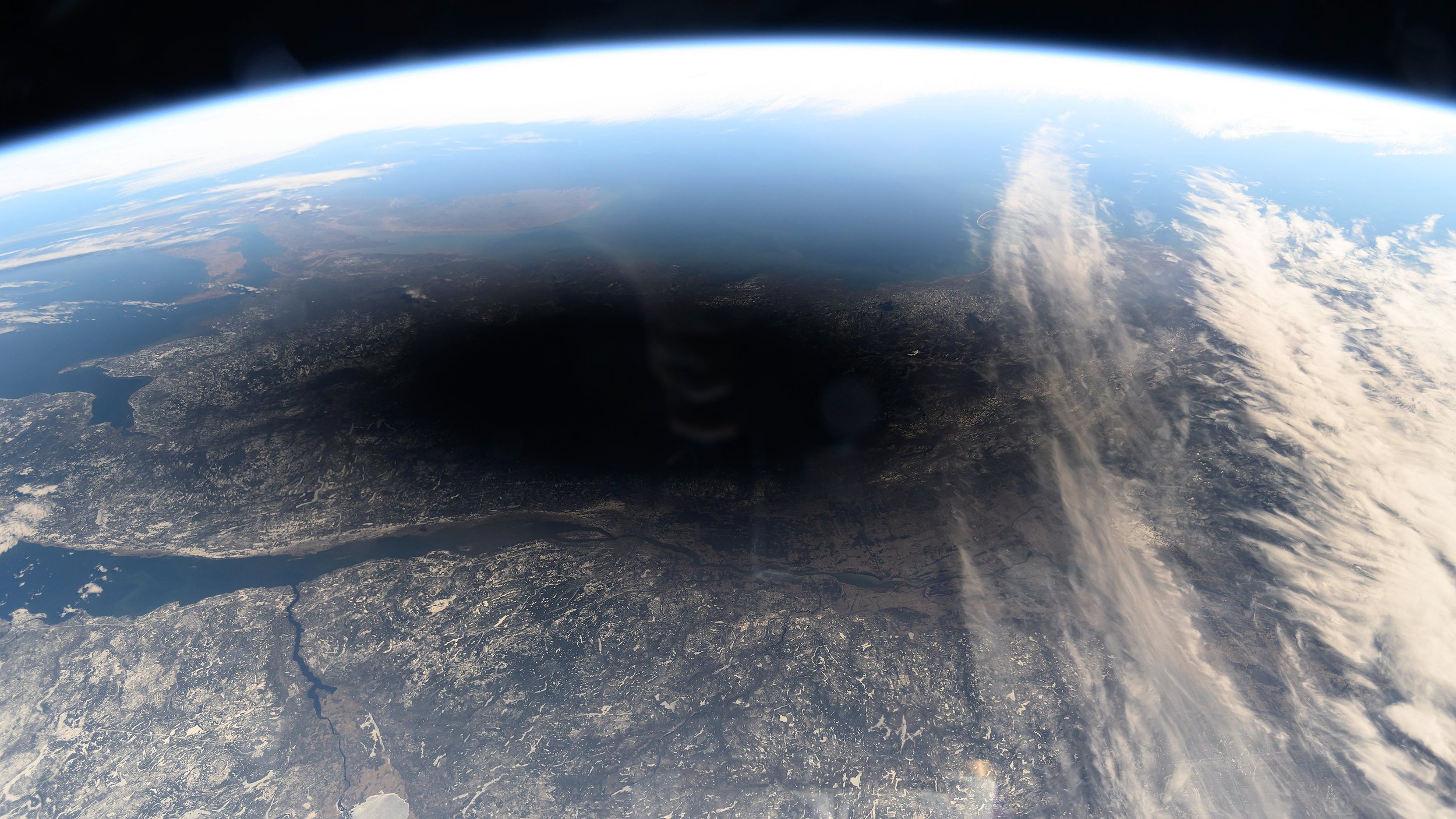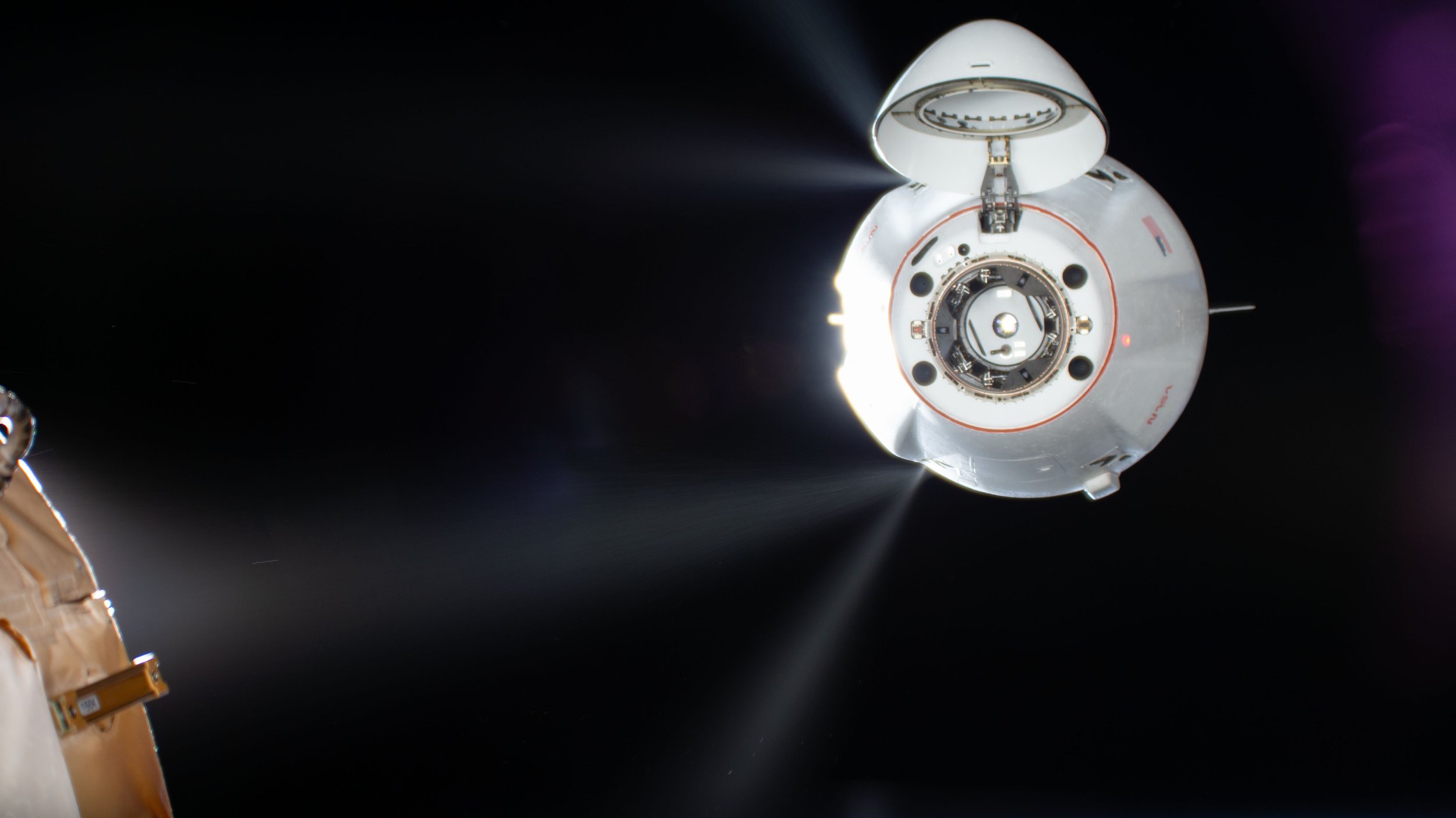“Here's a view of Saturn's moon Prometheus, made from images captured with the narrow-angle camera on Cassini on December 6, 2015. Cassini was about 37,400 km from Prometheus when the images were acquired. Part of the F ring is visible in the background at the top.” — Jason Major
Saturn Vortex
“This is a view of a ~2,000-km-wide vortex of swirling clouds above Saturn's north pole, imaged in polarized light with Cassini's narrow-angle camera on November 27, 2012. I've processed the original monochrome image to approximate the color of the area at the time.” — Jason Major
Uranus is not as boring as we thought
“An animation of three near-infrared images of Uranus captured by the JWST Space Telescope with assigned representative colors. During processing, I aligned the rings separately to reduce the bubbling effect caused by different inclinations, making the planet appear to rotate on an almost flat plane.” —Andrea Luck
Mars Express is Still Making Great Images 20 Years Later
Mars Express was launched by the European Space Agency in 2003, and is ESA’s first Mars mission. In one shot, you can see Mars as a half-lit disk, with Phobos, its tiny moon, hovering above. Right below Phobos is Olympus Mons, the solar system's largest volcano, towering 22 km high and 600 km across—or as the Bad Astronomer says, “about the size of Colorado”.
Posted by Andrea Luck, by way of Bad Astronomy.
https://twitter.com/ThePlanetaryGuy
Eclipse 2024 from Space
Dust Storm On Mars
A dust storm in Olympia Planum's north polar dune fields was triggered by a late Martian summer cold front. As the northern polar cap shrinks fast, it releases cold air that sometimes moves south, like on Earth. These cold fronts strengthen in late summer and early fall due to temperature differences. Occasionally, they cause big dust storms covering large areas or the whole planet. A similar event happened a month later, leading to a global dust storm lasting most of 2018. The image, taken on April 3, 2018, by the Mars Express HRSC camera during orbit, shows natural colors. [ see full image by Aster Cowart ]
Goodbye Ingenuity
Mission completed. Ingenuity is left alone on Mars after damage to one of its blades renders it inoperable..
Space-X Looking Like 2001 Space Odyssey
Amazing shot. Looks like a movie.
New View of IO from JUNO!
From processor Ted Styrk, “The Juno Jupiter orbiter flew by Io, Jupiter's super-volcanic moon, on May 16, returning arguably the best imagery of the moon since the Galileo Orbiter around the beginning of this century. Definitely the best since New Horizons in 2006.”
JUPITER FROM JUNO
An unusual perspective, captured by NASA's Juno spacecraft in 2018.
URANUS FROM THE JAMES WEBB SPACE TELESCOPE
This is not natural light, nothing is from Webb. The infrared image combines data from two filters which are shown in blue and orange,. The planet displays a blue hue in the resulting representative-color image which is similar to the planet’s actual color. But in reality Uranus is more a pale blue/green.
This is only the third facility to ever image the rings of Uranus: Voyager 2 spacecraft in 1986; and the Keck Observatory with advanced adaptive optics.
Europa Seen by Juno
Citizen scientist Björn Jónsson processed the image to enhance the color and contrast.
Neptune from the James Webb Space Telescope
Webb’s latest image is the clearest look at Neptune's rings in 30+ years, and our first time seeing them in infrared light. Take in Webb's ghostly, ethereal views of the planet and its dust bands, rings and moons: https://go.nasa.gov/3RXxoGq #IAC2022
Apollo Lunar Rover Video Corrected Speed and Stabilized
It is remarkable the difference watching this version where the time is corrected and camera stabilized.. The film restorer behind DutchSteamMachine used AI to stabilize shaky footage and generate new frames in NASA moon landing films; increasing the frame rate, smoothed the motion and made it look more like high-definition video. See more of their Apollo clips here.
Triton Image from Voyager Colored
Nice update to an old Voyager image with colors added based on actual colors captured in other images. See original post here by Jason Major.
Webb’s Jupiter
So this is “false color” becuase it is infrared (like all Webb images) and made from only two filters orange and cyan. However, the detail is incredible. That dot is tiny Amalthea at the left and— yes… that is Jupiter’s elusive ring. According to researcher Thierry Fouchet, “This one image sums up the science of our Jupiter system program, which studies the dynamics and chemistry of Jupiter itself, its rings, and its satellite system,”.
Saturn Family Portrait
From planetary.org: On July 29, 2011, Cassini captured five of Saturn’s moons in a single frame with its narrow-angle camera: Janus, Pandora, Enceladus, Rhea, and Mimas. NASA/JPL-Caltech/Space Science Institute. This is a full-color look at a view that was originally published in September 2011.
COMET 67P/CG ANIMATED FROM ROSETTA STILLS
Hit play.
Ganymede Sets Behind Jupiter as Seen by Hubble
An image taken by the Hubble Space Telescope reminds us of how powerful this aging scope really is. Magnitudes sharper than the images originally sent by Pioneer as it passed by in the 1970s.
Venus from Earth (with Stacking)
Image taken by @TheVastReaches. According to the photographer, “It takes just a few minutes to collect all the frames. This started as 6 video files, 45,000 frames total. Then they are stacked and combined.”
















